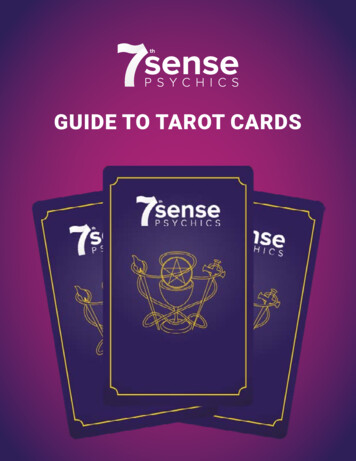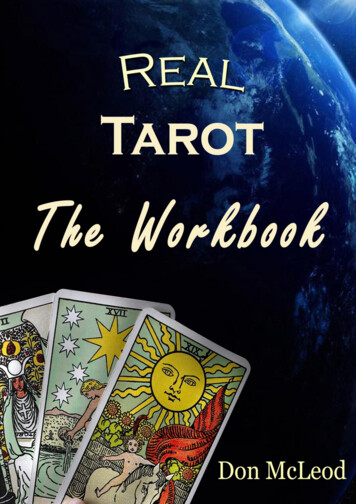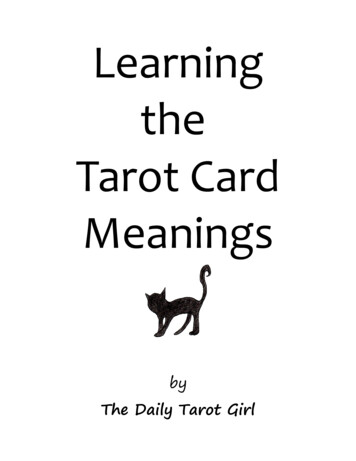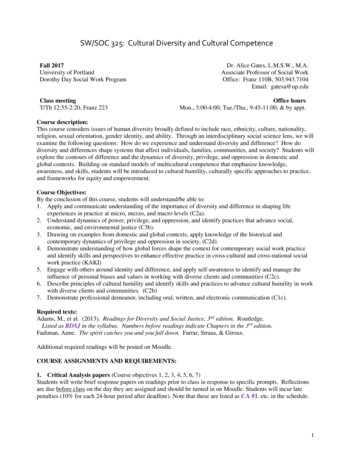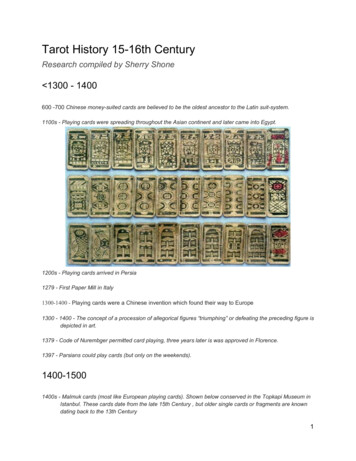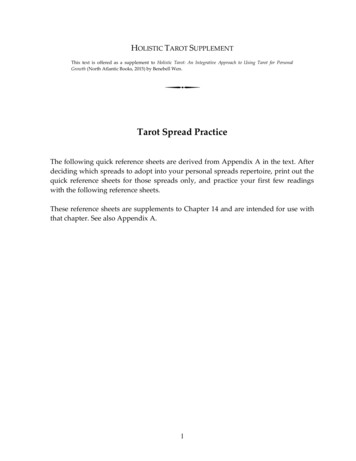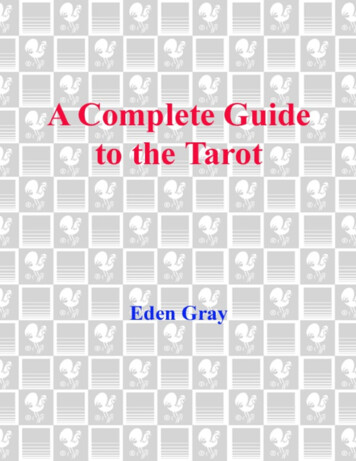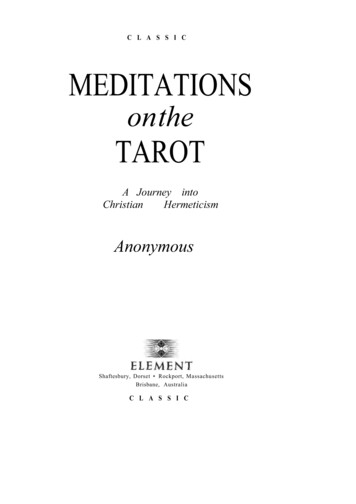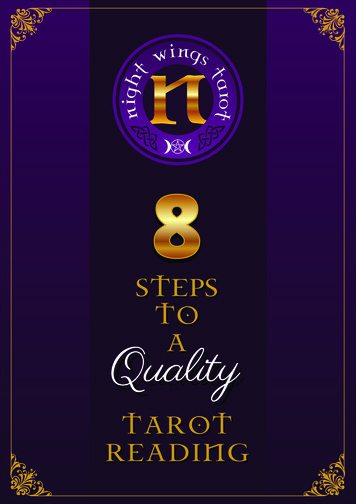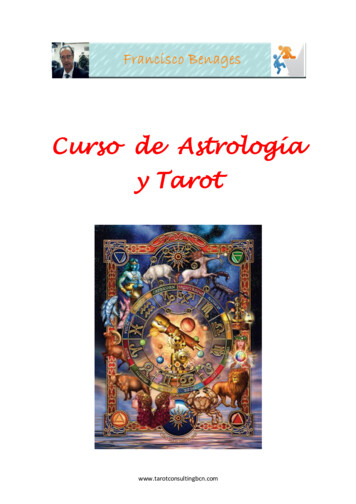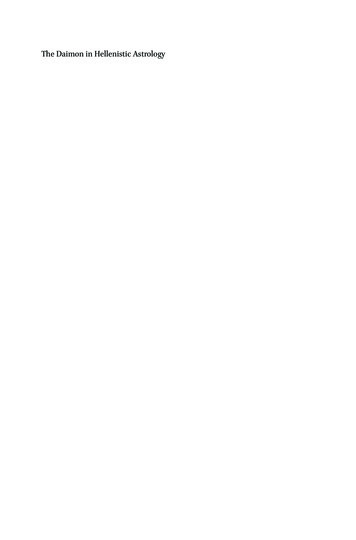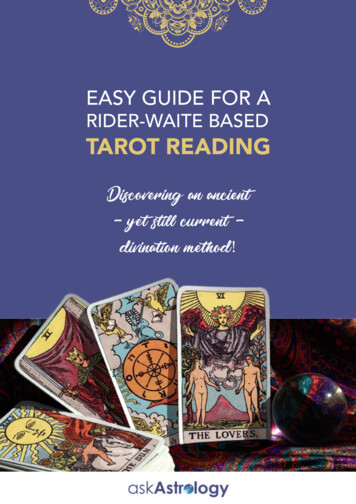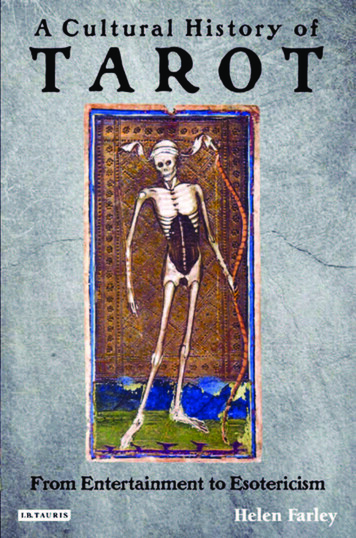
Transcription
A Cultural History of Tarot
iiA CULTURAL HISTORY OF TAROTHelen Farley is Lecturer in Studies in Religion and Esotericism at theUniversity of Queensland. She is editor of the international journalKhthónios: A Journal for the Study of Religion and has written widely on avariety of topics and subjects, including ritual, divination, esotericism andmagic.
CONTENTSA Cultural History of TarotFrom Entertainment to EsotericismHELEN FARLEYiii
Published in 2009 by I.B.Tauris & Co Ltd6 Salem Road, London W2 4BU175 Fifth Avenue, New York NY 10010www.ibtauris.comDistributed in the United States and Canada Exclusively by Palgrave Macmillan175 Fifth Avenue, New York NY 10010Copyright Helen Farley, 2009The right of Helen Farley to be identified as the author of this work has beenasserted by the author in accordance with the Copyright, Designs and Patents Act1988.All rights reserved. Except for brief quotations in a review, this book, or any partthereof, may not be reproduced, stored in or introduced into a retrieval system, ortransmitted, in any form or by any means, electronic, mechanical, photocopying,recording or otherwise, without the prior written permission of the publisher.ISBN 978 1 84885 053 8A full CIP record for this book is available from the British LibraryA full CIP record for this book is available from the Library of CongressLibrary of Congress catalog card: availablePrinted and bound in Great Britain by CPI Antony Rowe, Chippenhamfrom camera-ready copy edited and supplied by the author
vCONTENTSContentsList of IllustrationsList of TablesAcknowledgementsIntroductionviiixxi1Chapter 1: Origins and AntecedentsThe Emergence of the Playing Card DeckSome Theories of Tarot Origin6818Chapter 2: Renaissance Italy and the Emergence of TarotThe First Tarot DeckThe Viscontis and the Italian RenaissanceThe Purpose of the DeckTarot Imagery3335394345Chapter 3: An Alternative Explanation of Tarot SymbolismThe Magician/Il BagatellaTemporal and Spiritual Power: The Emperor and Empress, the Pope andthe PopessLoveThe Chariot MisidentifiedThe Virtues: Fortitude, Justice and TemperanceThe Old Man as TimeThe Wheel of FortuneThe Hanged ManDeathThe Star, Moon and Sun: Astrology in Renaissance ItalyAngelThe WorldNot a Tarot Trump but still the FoolThe Tower: Absent or Lost?The Devil in the Deck5051Chapter 4: The Transformation of Tarot into an Esoteric DeviceFrance in the Eighteenth CenturyOccult PhilosophiesAntoine Court de 101106
viA CULTURAL HISTORY OF TAROTÉliphas LéviPapus111117Chapter 5: Across the Channel to EnglandThe Nature of British OccultismWilliam Wynn WestcottS. L. MathersThe Hermetic Order of the Golden DawnAleister CrowleyWilliam Butler YeatsArthur Edward Waite121122126128129137142144Chapter 6: Tarot and the New AgePredominant Themes of New Age ThoughtCombining Traditions and MethodsThe Influence of FeminismNeopaganismA Fascination with other Religions and Cultures: Great and SmallHistory bliographyIndex177235265
.13.Mamlnjk playing cards now housed in the TopkapiSarayi Museum, Istanbul.The Tarocchi Players, Casa Borromeo, Milan.The Bishop by Hans Holbein, first half of the sixteenth century.The Popess from the Visconti-Sforza deck housed in thePierpont Morgan Library, New York.Fortitude from the Visconti-Sforza deck housed in thePierpont Morgan Library, New York.The Hanged Man from the Visconti-Sforza deck housedin the Pierpont Morgan Library, New York.Death from the Visconti Sforza deck housedin the Pierpont Morgan Library, New York.The Fool from the Visconti Sforza deck housedin the Pierpont Morgan Library, New York.The Moon from a contemporary version of the Tarot of Marseille.The Devil from a contemporary version of the Tarot of Marseille.The World from a contemporary version of the Tarot of Marseille.The Hanged Man recast as Prudence by Antoine Court deGébelin in Le Monde Primitif.Isis figures in Court de Gébelin’s version of The Star in LeMonde Primitif.Lévi’s Baphomet as the Devil in Dogme et rituel de la haute magie.Lévi’s Chariot as portrayed in Dogme et rituel de la haute magie.The Moon card as represented in the Cipher Manuscript.The Hierophant from Crowley’s Thoth Tarot.Lust replaces Strength in Crowley’s trump sequence.The Magus from Crowley’s Thoth Tarot.The Fool from the Rider Waite deck.The High Priestess from the Rider Waite deck.Death from the Rider Waite deck.The Kaiser replaces the Emperor in the Anti-NuclearWendländisches Tarot (1980).24. Black Tortoises replace wands in the Feng Shui Tarot ofEileen and Peter Paul Connolly.25. Odin plays the role of Emperor in the Haindl Tarot.26. Marie Laveau replaces the Priestess in the New OrleansVoodoo 167
viiiA CULTURAL HISTORY OF TAROT27. Simbi d’l’eau adorns the equivalent of the 8 of Cups in theNew Orleans Voodoo Tarot.28. The Wild Card is a novel addition to the New Orleans VoodooTarot.168169
CONTENTSixTables1.2.Region-specific suit signs of tarot and ordinary playing cards.The alignment of the ‘celestial princes and barons’with the four orders.3. Structure of the Etteilla tarot deck.4. A comparison of Etteilla’s tarot cards with the Tarot deMarseille tarot trumps.5. A table of correspondences to Hebrew letters formulatedby Athanasius Kircher. Planetary spheres were arranged accordingto their supposed distance above the earth, from Saturn tothe Moon as the closest.6. Correspondences associated with tarot suit signs accordingto Éliphas Lévi.7. Table of correspondences between the tarot trumps and theHebrew letters according to Éliphas Lévi and the Cipher Manuscript.8. Correspondences as given in the Sefer Yesi̛ rah, by Papusand in the Cipher Manuscript.9. Court card correspondences as described by Mathersin Book T.10. The table of correspondences drawn up by Yeats while hewas still a member of the Theosophical Society.11. A table of correspondences between the four tarot suits andother systems including Jung’s four functions of personality usedin the New Tarot.736108110115117133134136143156
xA CULTURAL HISTORY OF TAROT
ILLUSTRATIONSxiAcknowledgementsA book is a substantial undertaking and it cannot be completed withoutconsiderable support from colleagues, friends and family. I am fortunate inthat I am well-endowed with all those people such that I hardly know how towhittle down my list. I would like first to thank Professor Emeritus PhilipAlmond who has uncomplainingly read drafts and made many helpfulsuggestions.Research travel is very expensive and I could not have undertaken itwithout the generous financial support of the University of QueenslandGraduate School through the Graduate School Research Travel Awardscheme. I would also like to acknowledge the generous support of theSchool of History, Philosophy, Religion and Classics and also to theAustralian Association for the Study of Religion (AASR) for providing mewith the funds to attend conferences and spread the seeds of my academicexploration.My research in Milan and London was greatly facilitated by many peoplewho had not previously met me yet bent over backwards to meet my needs. Iwould particularly like to mention Patrizia Foglia at la Raccolta Bertarelli atthe Castello Sforzesco in Milan. In London, I would like to extend mygratitude to John Fisher of the Guildhall Library; Jo Norman of theDepartment of Prints and Drawings at the British Museum; Frances Rankineof the Prints and the Book, Word & Image Department of the Victoria andAlbert Museum and the staff of the National Art Library.From I.B.Tauris I would like to express my gratitude to Alex Wright whobelieves that a book about tarot is viable! Thanks must also go to Jayne Hillwho has tirelessly pored over my copy; every comma and fullstop.I reserve my thanks til last to my partner, James Boland, for hisencouragement, support and good humour; for listening to the complicatedexposition of my arguments when he would rather have been playing hisguitar and for celebrating every word, every chapter and every milestonealong the way.
IntroductionWhen we think of tarot, images of fortune-tellers, crystals and incense flashpast our mind’s eye. Those with more romantic dispositions may imaginedark-eyed gypsies in colourful caravans, wending their way through thecountryside, telling fortunes with cards for the curious few brazen enough topeek at their destiny before its blossoming. Outsized cards are shuffled, laidout and ‘read’; the order in which they are drawn, their symbolism and theirposition relative to each other are all significant for folk with eyes to see.Those who wish to possess a pack for themselves are confronted by abewildering variety of decks: pagan tarots, astrological tarots, gypsy tarots, anynumber of Egyptian tarots, even a Metrosexual Tarot.1In contemporary society where empirical scientific enquiry and strictrationalism are paramount, tarot has been associated with shoddysoothsayers and confidence tricksters, and it is in part for this reason thatacademics have deemed the area unsuitable for detailed examination.Though there is a paucity of scholarly works, there are numbers almostwithout limit of popular tarot monographs, which line the shelves of NewAge bookstores and ‘Self-Help’ corners of department stores. In embarkingon an academic study, it is difficult to separate historical fact from esotericfiction, where elegant myths are recycled ad infinitum. Many authors wouldhave us believe that the tarot contains the lost Hermetic knowledge of aproud and noble Egyptian race who encoded their secrets when faced withuntimely extinction. Such myths, never verified by their perpetrators, havetheir origin in the desire for pseudo-legitimacy through an ancient, thoughfalse, lineage and the dogged persistence of a pre-Rosetta infatuation with allthings Egyptian.In order to correct this deficiency, this book forms the first comprehensivecultural history of the tarot deck and its imagery. The symbolism, changes inpatterns of use and theories of tarot origin become entirely comprehensiblewhen viewed in conjunction with the cultural contexts in which theyoccurred. Four significant periods in tarot’s history are considered, beginningwith an investigatation of the popular theories of the deck’s provenance inorder to accurately determine the circumstances of its invention. Thereclusive Duke Filippo Maria Visconti of Milan is the most likely candidatefor inventor of that first deck, sometime early in the fifteenth century. A closeinvestigation of the spiritual and mundane concerns of the Italian
2A CULTURAL HISTORY OF TAROTRenaissance brings to light the meaning in the mysterious symbolism of theseearly decks; at this time used solely for game playing. Could it have been thatthat this innocuous game of some skill and much chance was an allegory forthe life of the Viscontis as rulers of Milan, similarly characterised by adizzying mix of rat-cunning and luck?In late-eighteenth-century France, tarot was so far removed from itsoriginal cultural context that the ready decryption of its symbolism becameimpossible. Instead it was reinterpreted according to a new set of intellectualcurrents which included an infatuation with exotic cultures, esoteric doctrinesand an ardent yearning for a lost Golden Age. In particular, France wasgripped by Egyptomania, fuelled by Napoleon’s conquest of that exotic land.The failure of the Church to adapt to the changing political, social andspiritual circumstances enabled the emergence of the alternative and esotericdoctrines which would constitute the French Occult Revival. It was in thismilieu that tarot was transformed from a Renaissance game to an esotericdevice, legendarily created in an Egypt still perceived to be the repository ofarcane knowledge. It was linked to all manner of abstruse schemes includingHermeticism, astrology and kabbalah by esotericists, most notably ÉliphasLévi and Gérard Encausse, otherwise known as Papus.The next significant development in tarot occurred in England, also in thegrip of the Occult Revival. Under the influence of the Hermetic Order of theGolden Dawn, tarot would become central. Though never possessing morethan 300 members, the Golden Dawn was enormously influential on thepractice of magic and tarot interpretation. These nineteenth-centurymagicians altered the trump sequence and linked each card to one of thetwenty-two pathways between the sephiroth on the kabbalistic Tree of Life.These pathways lent a divinatory interpretation to each card which forms thebasis of contemporary divinatory meanings.Two Golden Dawn members who would play a significant role in theevolution of tarot were Aleister Crowley and Arthur Edward Waite. Crowleyextended the lists of correspondences between the tarot trumps and otheresoteric systems. But it was Waite who was to be the major innovator bydesigning a pack in which the minor arcana or pip cards were illustrated tofacilitate divination. The deck he designed, commonly known as the RiderWaite deck, was to become the most popular in the history of tarot.With the advent of the New Age, the tarot underwent yet anothertransformation. Though retaining its primary purpose of divination, thenature of that divination shifted; where once the deck was used for fortunetelling, the object became healing and self-development, both central to theNew Age movement. In addition, New Age seekers were intrigued withEastern and indigenous religions, searching for commonalities that wouldexpose an underlying truth in all the world’s spiritual systems. The New Age
INTRODUCTION3adoption of Jungian psychology justified many of its practices including theliberal use of the theory of archetypes to validate ad hoc borrowings andsubstitutions from other cultures in the symbolism of tarot.
16. The Moon card as represented in the Cipher Manuscript. 135 17. The Hierophant from Crowley’s Thoth Tarot. 137 18. Lust replaces Strength in Crowley’s trump sequence. 138 19. The Magus from Crowley’s Thoth Tarot. 140 20. The Fool from the Rider Waite deck. 145 21. The High Priestess from the Rider Waite deck. 146 22. Death from the Rider Waite deck. 147
